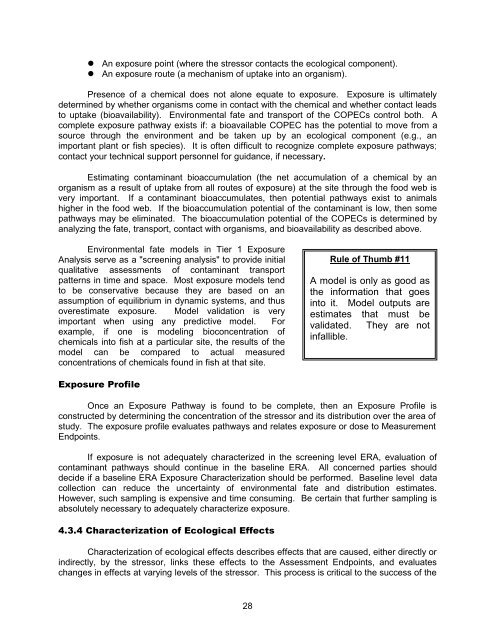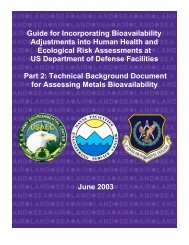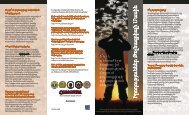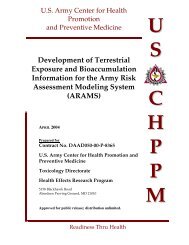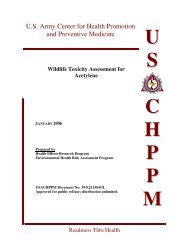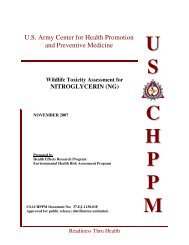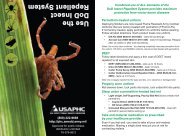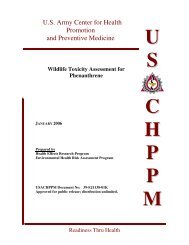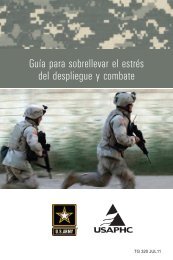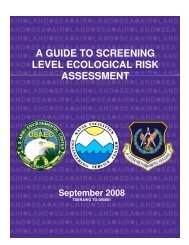Tri-Service Remedial Project Manager's Guide for Ecological Risk ...
Tri-Service Remedial Project Manager's Guide for Ecological Risk ...
Tri-Service Remedial Project Manager's Guide for Ecological Risk ...
You also want an ePaper? Increase the reach of your titles
YUMPU automatically turns print PDFs into web optimized ePapers that Google loves.
l An exposure point (where the stressor contacts the ecological component).l An exposure route (a mechanism of uptake into an organism).Presence of a chemical does not alone equate to exposure. Exposure is ultimatelydetermined by whether organisms come in contact with the chemical and whether contact leadsto uptake (bioavailability). Environmental fate and transport of the COPECs control both. Acomplete exposure pathway exists if: a bioavailable COPEC has the potential to move from asource through the environment and be taken up by an ecological component (e.g., animportant plant or fish species). It is often difficult to recognize complete exposure pathways;contact your technical support personnel <strong>for</strong> guidance, if necessary.Estimating contaminant bioaccumulation (the net accumulation of a chemical by anorganism as a result of uptake from all routes of exposure) at the site through the food web isvery important. If a contaminant bioaccumulates, then potential pathways exist to animalshigher in the food web. If the bioaccumulation potential of the contaminant is low, then somepathways may be eliminated. The bioaccumulation potential of the COPECs is determined byanalyzing the fate, transport, contact with organisms, and bioavailability as described above.Environmental fate models in Tier 1 ExposureAnalysis serve as a "screening analysis" to provide initialqualitative assessments of contaminant transportpatterns in time and space. Most exposure models tendto be conservative because they are based on anassumption of equilibrium in dynamic systems, and thusoverestimate exposure. Model validation is veryimportant when using any predictive model. Forexample, if one is modeling bioconcentration ofchemicals into fish at a particular site, the results of themodel can be compared to actual measuredconcentrations of chemicals found in fish at that site.Rule of Thumb #11A model is only as good asthe in<strong>for</strong>mation that goesinto it. Model outputs areestimates that must bevalidated. They are notinfallible.([SRVXUH3URILOHOnce an Exposure Pathway is found to be complete, then an Exposure Profile isconstructed by determining the concentration of the stressor and its distribution over the area ofstudy. The exposure profile evaluates pathways and relates exposure or dose to MeasurementEndpoints.If exposure is not adequately characterized in the screening level ERA, evaluation ofcontaminant pathways should continue in the baseline ERA. All concerned parties shoulddecide if a baseline ERA Exposure Characterization should be per<strong>for</strong>med. Baseline level datacollection can reduce the uncertainty of environmental fate and distribution estimates.However, such sampling is expensive and time consuming. Be certain that further sampling isabsolutely necessary to adequately characterize exposure.&KDUDFWHUL]DWLRQRI(FRORJLFDO(IIHFWVCharacterization of ecological effects describes effects that are caused, either directly orindirectly, by the stressor, links these effects to the Assessment Endpoints, and evaluateschanges in effects at varying levels of the stressor. This process is critical to the success of the28


